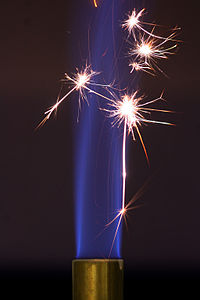Incandescence

Incandescence is the emission of light (visible electromagnetic radiation) from a hot body due to its temperature.[1] The term derives from the verb incandesce, to grow white.[2]
The incandescence of a theoretically perfectly black object is known as black body radiation, which is described by relatively simple mathematical equations. For a black body, the distribution of energy emissions across the electromagnetic spectrum is described by Planck's law. The total power emitted by radiation from a black body is given by the Stefan–Boltzmann law. Wien's displacement law predicts the wavelength of peak emission.
Incandescence occurs in incandescent light bulbs, because the filament resists the flow of electrons. This resistance heats the filament to a temperature where part of the radiation falls in the visible spectrum. The majority of radiation, however, is emitted in the invisible infrared part of the spectrum, which is why incandescent light bulbs are inefficient.[3]
Fluorescent lamps do not function by means of incandescence, rather by a combination of thermionic emission and atomic excitation due to collision with high energy electrons. In an incandescent lamp, only the electrons at the top of the band can participate. Higher temperature can increase efficiency but we do not have materials that can withstand much higher temperature.
See also
References
- ^ Dionysius Lardner (1833). Treatise on Heat. Longman, Rees, Orme, Brown, Green & Longman.
The state in which a heated body, naturally incapable of emitting light, becomes luminous, is called a state of incandescence.
- ^ John E. Bowman (1856). An Introduction to Practical Chemistry, Including Analysis (Second American edition ed.). Philadelphia: Blanchard and Lea.
{{cite book}}:|edition=has extra text (help) - ^ William Elgin Wickenden (1910). Illumination and Photometry. McGraw-Hill.
